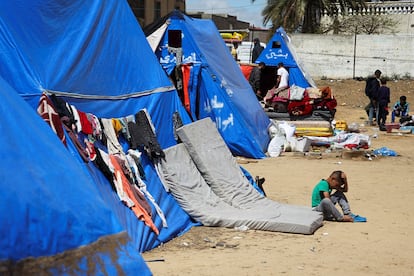Why take Rafah now? Israel’s latest operation condemns thousands of Gazans to an impossible exodus
The Israeli army has ordered the inhabitants of the city to move to supposed ‘safe zones,’ but these areas have been previously attacked and lack basic infrastructure


On January 6, 2024, a United Nations assessment concluded that there is “no safe place” in Gaza. Not even Rafah, the southernmost city in the Gaza Strip, designated as a “safe zone” by Israel, even though its military never stopped bombing it. Already in January, 1.5 million of the 2.3 million Gazans were crowded into the city and its governorate, a 25-square mile area next to the border with Egypt. In early February, Israeli Prime Minister Benjamin Netanyahu announced that the Israeli army would invade Rafah. That ground offensive — which the U.N. warned could lead to an “unspeakable tragedy” — has since been a sword hanging over the head of these displaced Palestinians.
On Monday, the threat began to materialize when Israel ordered 100,000 people to evacuate to supposed “safe areas” of the Palestinian enclave. On Tuesday, Israeli tanks took over the Rafah border crossing, the only one that Israel did not fully control. “An assault on Rafah would be a strategic mistake, a political calamity & a humanitarian nightmare,” said U.N. Secretary-General António Guterres.
Why take Rafah now?
Israeli Defense Minister Yoav Gallant said Monday that his country was left with “no choice” but to invade Rafah. The day before, in the last round of talks in Cairo to negotiate an agreement to free the 132 Israeli hostages still in Gaza, Hamas had rejected a proposal that did not include the main condition of the Palestinian movement: a definitive ceasefire. On Sunday, the fundamentalist group attacked a military garrison near the Kerem Shalom border crossing and killed four Israeli soldiers. That same day, Israel closed the Jerusalem headquarters of the Al Jazeera network.
According to The New York Times, it was Netanyahu’s insistence that he would invade Rafah that led Hamas to harden its stance. Late on Monday, a statement from Hamas political chief Ismail Haniyeh said that the movement had finally approved a proposed ceasefire agreement, which Israel said it would study. Shortly after, Netanyahu said that the offensive in Rafah was continuing and on Tuesday, Israeli tanks reached the city’s border crossing with Egypt. The Israeli prime minister claims that Rafah is the last bastion of Hamas, and where the remaining Israeli hostages, dead or alive, are being held captive in Gaza. His far-right government partners threatened to withdraw their support if he did not invade the Palestinian city.
What consequences could this invasion have?
In the Rafah Governorate — which had a population of about 220,000 people before the war that began on October 7 — 1.5 million Palestinians are now crowded into 25 square miles. Eighty percent live in tents or under plastic shelter, with hardly any food, drinking water, sanitation or medical care. On May 3, the spokesperson for the U.N. Office for the Coordination of Humanitarian Affairs (OCHA), Jens Laerke, warned: “The hundreds of thousands of people who are there would be at imminent risk of death if there is an assault [on Rafah].” It would also be “an incredible blow to the humanitarian operation in the entire strip because it is run primarily out of Rafah,” he said. The World Health Organization warned that such an operation could lead to a “bloodbath” and would further paralyze “an already broken health system.” Of the seven partially functioning hospitals in southern Gaza, three are in Rafah. Until now, the vast majority of trucks with humanitarian aid for Gaza entered through the border posts at Rafah and Kerem Shalom, which are now both closed.
Are there safe areas for displaced people in Gaza?
The so-called safe zones where Israel has ordered displaced people from Rafah to go to are Al-Mawasi — a coastal strip seven miles long and less than one mile wide that lacked services even before the war — and the nearly destroyed city of Khan Yunis. It has called this area the “expanded humanitarian zone.” Part of Al-Mawasi was invaded by the Israeli army on January 22, even though it had been designated as a refuge. Until now, Rafah was also described as a “safe zone” despite suffering almost daily shelling. An investigation by Forensic Architecture, a research agency based at Goldsmiths, University of London, denounced that these “safe zones” in Gaza not only “lack the basic infrastructure to house, feed and medically care for such numbers of civilians,” but what Israel defines as its “humanitarian policies” in Gaza function as “a tool of mass displacement, pushing civilians into unliveable areas that later come under attack, augmenting Israel’s genocidal campaign against the Palestinian population.”
Are mass population displacements legal?
Israel is the occupying power in Gaza, according to the U.N. The Geneva Convention stipulates: “Individual or mass forcible transfers” are prohibited, “regardless of their motive.” Even in the few exceptions provided for in this rule, it states that the occupying power must “ensure, to the greatest practicable extent, that proper accommodation is provided to receive the protected persons, that the removals are effected in satisfactory conditions of hygiene, health, safety and nutrition, and that members of the same family are not separated.”
What have been the reactions to the Rafah evacuation order?
U.S. President Joe Biden reiterated Monday his “clear position” on the offensive in Rafah in a call with Netanyahu. Washington does not oppose the invasion itself, but on the condition that Israel present a “credible” plan to protect civilians. The head of European diplomacy, Josep Borrell, urged the EU to act to stop the invasion, which he has called “unacceptable,” while U.N. spokesman Stéphane Dujarric read a statement on Monday in which he reiterated what had been previously announced by the United Nations agency for Palestinian Refugees (UNRWA): the organization will not participate in any massive and “involuntary” displacement of the population. Saudi Arabia — the great Sunni regional power, with which Israel had hoped to form diplomatic relations before the war — condemned the invasion in a harsh statement that called the Israeli offensive “genocide” for the first time since the start of the war.
Sign up for our weekly newsletter to get more English-language news coverage from EL PAÍS USA Edition
Tu suscripción se está usando en otro dispositivo
¿Quieres añadir otro usuario a tu suscripción?
Si continúas leyendo en este dispositivo, no se podrá leer en el otro.
FlechaTu suscripción se está usando en otro dispositivo y solo puedes acceder a EL PAÍS desde un dispositivo a la vez.
Si quieres compartir tu cuenta, cambia tu suscripción a la modalidad Premium, así podrás añadir otro usuario. Cada uno accederá con su propia cuenta de email, lo que os permitirá personalizar vuestra experiencia en EL PAÍS.
¿Tienes una suscripción de empresa? Accede aquí para contratar más cuentas.
En el caso de no saber quién está usando tu cuenta, te recomendamos cambiar tu contraseña aquí.
Si decides continuar compartiendo tu cuenta, este mensaje se mostrará en tu dispositivo y en el de la otra persona que está usando tu cuenta de forma indefinida, afectando a tu experiencia de lectura. Puedes consultar aquí los términos y condiciones de la suscripción digital.
More information
Archived In
Últimas noticias
There is as much life left to discover on planet Earth as that which is already known
Dozens presumed dead, around 100 injured in fire at Swiss Alps bar during New Year’s celebration
Is porn for women different from conventional porn? We spoke to those who make it
Cartagena de Indias is sinking: What can the city do to mitigate it?
Most viewed
- Reinhard Genzel, Nobel laureate in physics: ‘One-minute videos will never give you the truth’
- David King, chemist: ‘There are scientists studying how to cool the planet; nobody should stop these experiments from happening’
- Sinaloa Cartel war is taking its toll on Los Chapitos
- Oona Chaplin: ‘I told James Cameron that I was living in a treehouse and starting a permaculture project with a friend’
- The Interoceanic Train, the Mexican alternative to the Panama Canal









































